("bad ozone")
negative trend: -1.1 ug/m3 per year
1998-2012 mean
+/- stdev:
38.1 +/- 6.6 ug/m3
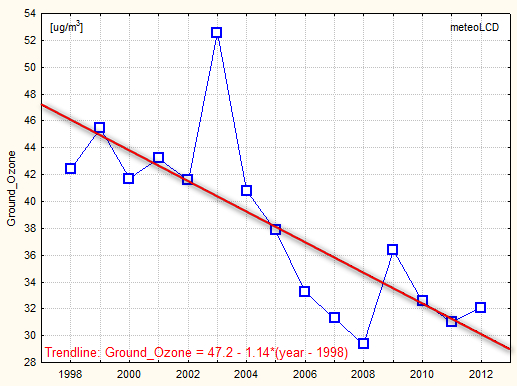
("good ozone")
positive trend: +2.1 DU per year, +0.3 since 2002
(Uccle gives +0.95 for the 1998-2010 period) (see also [16])
Calibration factors applied:
1998 to 2007: * 0.95
2008 to 2010: * 1.00
2011 : * 1.06
2012 : * 1.04
2012 common days measurements results:
Diekirch = 325.6 DU
Uccle DS = 328.1 DU
Uccle data are from WOUDC (stat.53, Brewer#16)
1998 to 2012 mean
+/- stdev:
Diekirch: 323.8 +/- 15.5
Uccle.: 328.8 +/- 3.5
(Uccle without 2009/10/11)
See [4] [8]
([8] shows strong
positive trend starting 1990 for
latitudes 45°-75° North, Europe): [27] give +1.32
DU/y at the Jungfraujoch for 1995-2004.
See also recent EGU2009 poster [16].
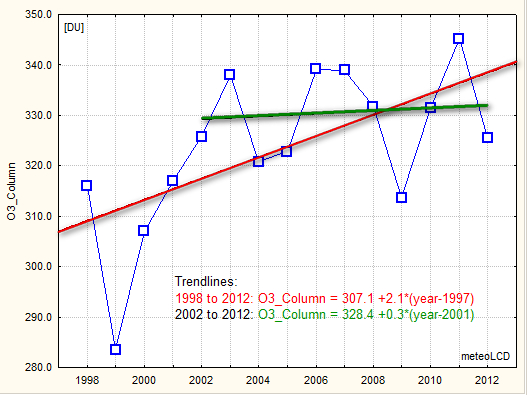
The 1998-2001 data are too unreliable to be retained
for the trend analysis.
2002 to 2011 mean
+/- stdev::
408.4 +/- 5.3 ppmV
trend = +1.35 ppmV per year
2007 to 2011:
trend: + 0.38 ppmV per year !
The right picture shows the asymptotic CO2 values
(CO2wind)
derived from the model published in [21] .
The blue upper curve shows the yearly mean
values at Diekirch; the middle red curve the
asymptotic CO2 values that would exist if wind velocity was infinite, and
the lower green curve the yearly averages at
Mauna Loa, augmented by +1.8 ppmV to respect the latitudinal gradient of
approx. 0.06 ppm per degree (MLO December data not yet available, average of
Jan to Nov. 2012 retained)
The asymptotic mixing ratios are reasonably close to those of Mauna Loa
(adjusted); the yearly trends calculated from the mean and asymptotic values
at Diekirch are close (1.35 and 1.22 ppmV*y-1). They are
visibly lower than the Mauna Loa yearly gradient of 2.02 ppmV*y-1
See also [25]
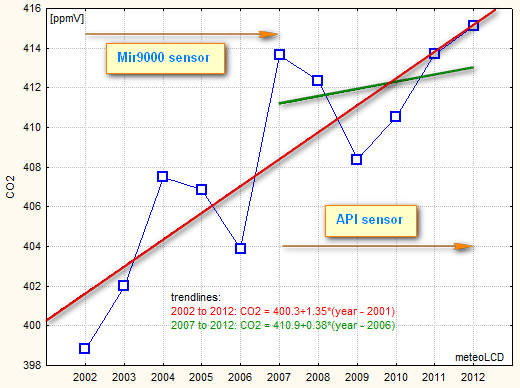
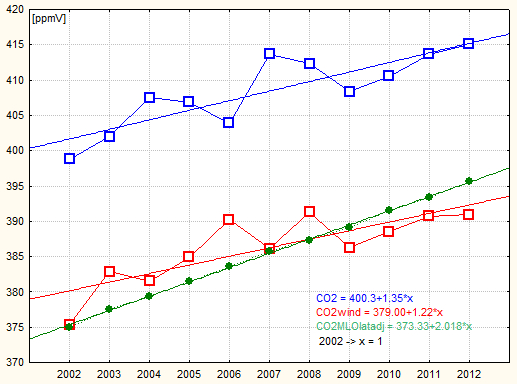
Trend from 1998 to 2012: +0.019 °C per year
1998 to 2012 mean
+/- stdev::
10.33 +/- 0.45 °C
2002 to 2011:
10.39 +/- 0.49 °C
The sensor has
not been moved since 2002!
Slightly cooling trend from 2002 to 2012:
meteoLCD: - 0.02°C/decade
Findel:
-0.19°C/decade
Global Land temperature trends also show cooling:
CRU (Hadcrut3): - 0.03°C/decad. [18]
UAH (satellite) :- 0.07°C/decad [26]
Highest decadal Central England warming trend from 1691 to 2009:
+1.86°C/decade for 1694-1703!
See also [15]
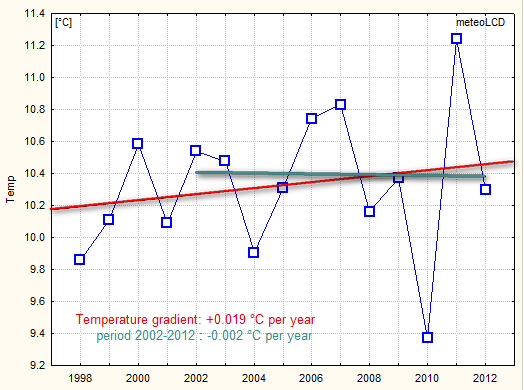
Range (DTR) [°C]
DTR = daily max - daily min temperature
positive trend: + 0.05 °C per year
1998 to 2012 mean
+/- stdev::
8.53 +/- 0.55 °C
2002 to 2012: all trends flat!
Note that for 1998-2012 daily maximum rises faster than daily minimum! The increase in DTR is also documented
here!
Since 2002, all three parameters have trends lower than +/-0.005 °C/y, i.e.
these trends lines are essentially flat. Same conclusion reached by
the BEST paper [29] on global land-based temperatures.
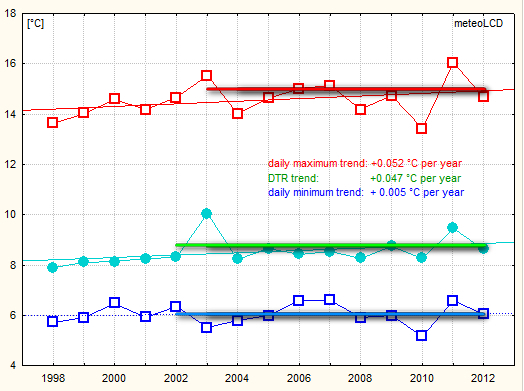
Contrary to what is often suggested in the media, winters are cooling since 2002. The cooling rates per decade are:
Diekirch: -0.43 °C/decade
Findel: -0.67 °C/decade
Germany: -1.02 °C/decade [31]
The plot shows the mean temperatures of
December (from previous year), January and February. It also shows in
brown (right Y-axis) the NAO index for the months Dec to Mar [32]
The North Atlantic Oscillation clearly
influences our winters; the correlation between the 3 different DJF series
and DJFM_NAO are 0.76, 0.77 and 0.78, all significant at the 5% level. The
NAO trend is also negative for the 2002 to 2012 period.

Trend from 1998 to 2012: - 17 mm per year
1998 to 2012 mean +/- stdev::mean :
708.7 +/- 148.3 mm
2002 to 2012:
653.7 +/- 119.2 mm
Rainfall in Diekirch may be very different from that at the Findel airport
! Total for 2012:
Diekirch = 800 mm, Findel = 951 mm
Good simple model: Sinus function of 7 years period with time dependant
amplitude (R2 = 0.36). Model correctly reflects rising
precipitation.
[6] gives medium term periods of 10 to12 years for the region from England to eastern Germany.
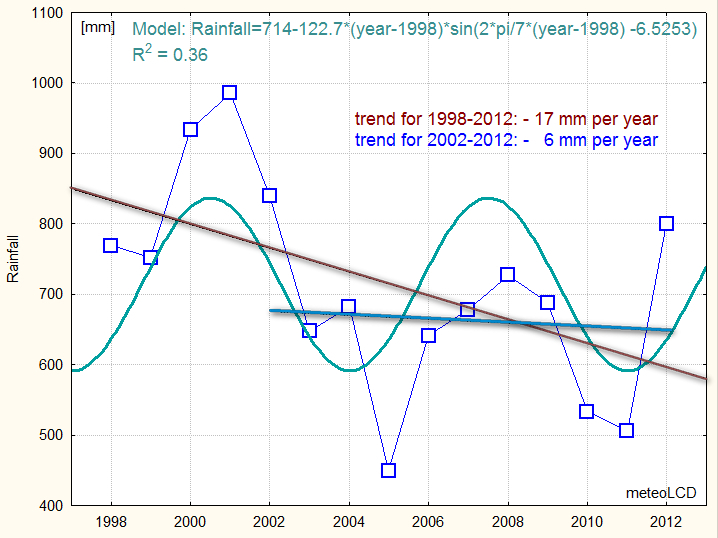
mean: 1113.5 kWhm-2
stdev: 48.8 kWhm-2
Visible negative trends:
1998 to 2012: -2.7 kWhm-2y-1
2004 to 2012: -5.8 kWhm-2y-1
(solar cycle #23
terminates December 2008).
The period 2005 to 2012 should cause a cooling of -0.04 °Cy-1 , assuming
solar energy being the sole radiative forcing and no feedbacks. ([19]). The meteoLCD
observations show from 2005 to 2012 a cooling of -0.02 °Cy-1 ,
reasonably close. (see
Addendum 1)
Helioclim satellite measurements show ongoing solar dimming over
Luxembourg for 1985 to 2005 [33] (see
graph)
[14] finds 0.7 Wm-2y-1
for West-Europe 1994-2003 , meteoLCD +1 Wm-2y-1 for
1998-2003.See also [9]
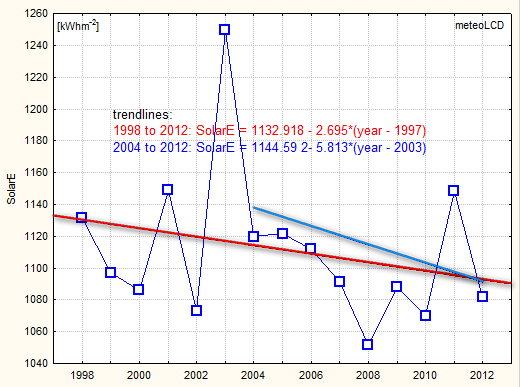
(derived from pyranometer data by Olivieri's method)
Total for 2012:
meteoLCD: 1637.5 hours
Findel: 1856.3
Trend: + 2.2 hours per year
1998 to 2012
mean +/-
stdev:
1666 +/- 169 hours
Note negative trend from 2004 to 2012:
- 7.8 hours per year.
See paper [23] by F. Massen comparing 4 different methods to compute sunshine duration from pyranometer
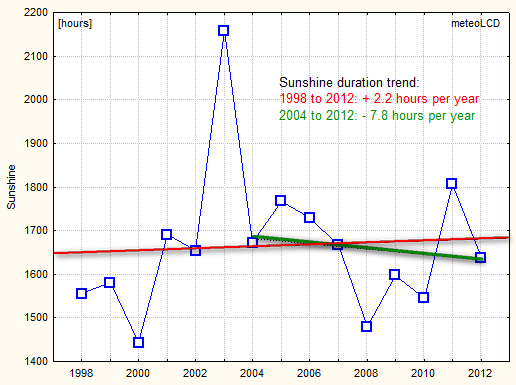
Practically flat trend line for the whole period.
1998 to 2012
mean +/-
stdev:
0.129 +/- 0.010 eff. kWh*m-2y-1
Practically flat trend from 1998 to 2012, but
visible negative trend of - 1 eff. Whm-2y-1 from 2004 to 2012,
in accordance to the dimmimg measured by
the pyranometer over the same period. So dimming is confirmed by both pyranometer and UVB sensor
See
[10]
and [22] (poster finds slight
positive trend in June (+2%) and negative trend in August (-1%), no trend
for other months, for period 1991 to 2008)
The decrease in biologically effective UVB is also consistent with the
increase of the total ozone column [28]
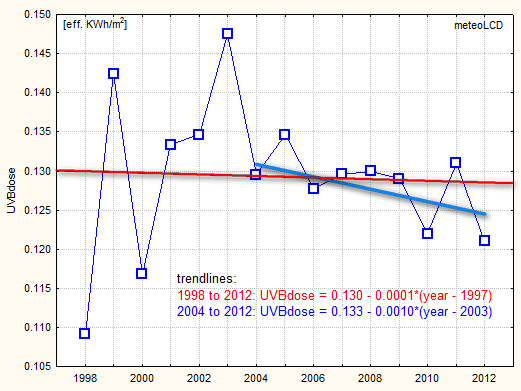
Positive trend: + 0.3 k Whm-2 per year, essentially caused by the very low 2004 reading.
1998 to 2012
mean +/-
stdev:
54.40 +/- 4.92 kWh/m2y-1
Note
exceptional high 2010 reading causing a small positive trend of +0.15 kWm-2y-1
. This positive trend is caused by the exceptional high 2010 value (which
was an extrapolation due to 8% missing data, and is dubious).
Without the 2010 value, the UVA dose trend from 2004 to 2012 is clearly
negative: - 245 Wm2y-1
The 3 independent measures of Solar energy, UVA and UVB dose all document a solar dimming since 2004.
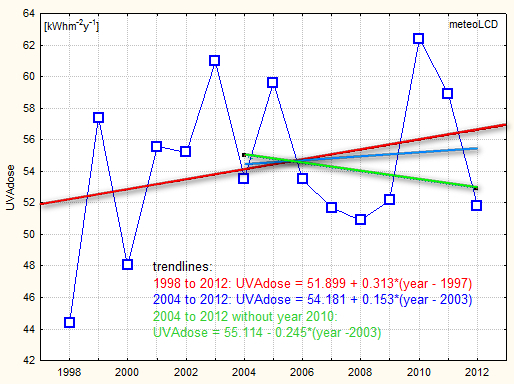
The 1998-1999 data are too unreliable to be retained.
2000 to 2012: trend = -0.3 ug/m3 per year
2002 to 2012
mean +/-
stdev:
9.4 +/- 1.6 ug/m3
2002 to 2012 trend: -0.2 ug/m3 per year
i.e. a reduction of 20%
Many (about 20 to 25%) missing data in 2011 and 2012, so be careful!
see [11] which gives ~30% reduction from 1990 to 2005 for the EU-15 countries.
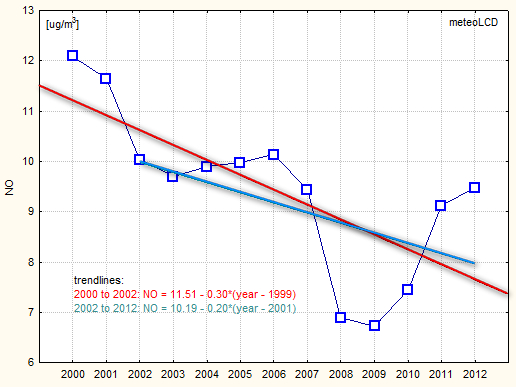
The 1998-1999 data are too unreliable to be retained.
2000 to 2012: trend: - 0.014 ug/m3 per year
~ flat!
2002 to 2012
mean +/-
stdev:
21.8 +/- 3.2 ug/m3
2002 to 2012: trend = + 0.16 ug/m3 per year
Many (about 20 to 25%) missing data in 2011 and 2012, so be careful!

See [24] on how the energy content of moist air is
calculated. Several authors, as Prof. Roger Pielke Sr. insist that air
temperature is a poor metric for global warming/cooling, and that the energy
content of the moist air and/or the Ocean Heat Content (OHC) are better.
Mean yearly moist enthalpy values are very close, but they may change from
close to zero up to 60 Kj/kg during a year. Moist enthalpy can not be
calculated for temperatures <= 0 °C.
2002 to 2012
mean +/-
stdev:
28.01 +/- 0.64 kL/kg
Trend is clearly negative: -0.1 KJ/kg per year which is consistent with
the trends in solar energy, UVA and UVB doses.

